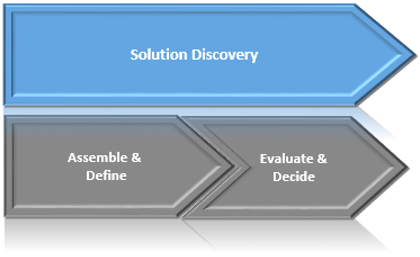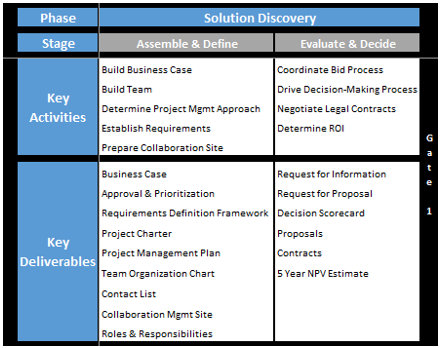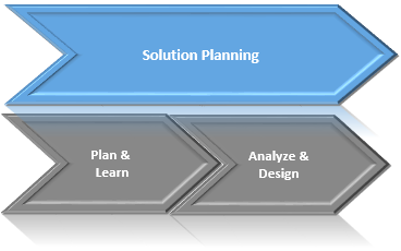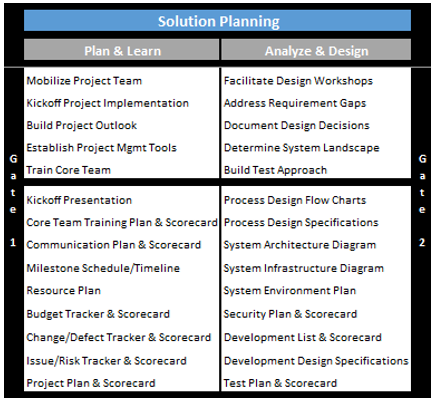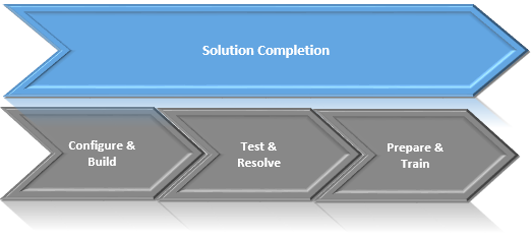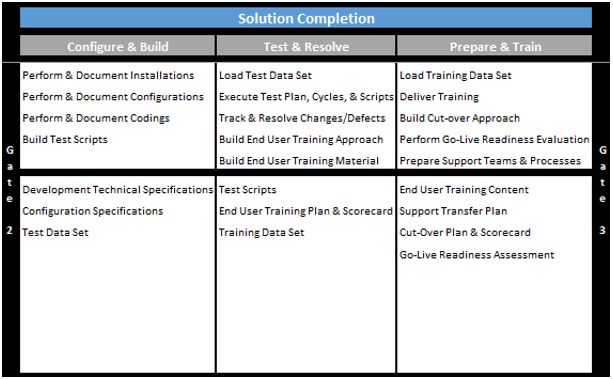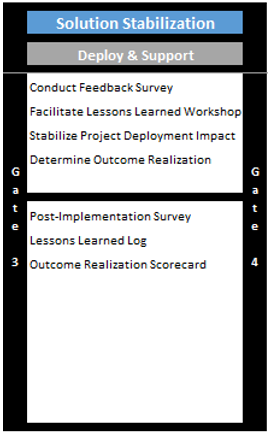Life Cycle Phases
Overview:
The Navigate methodology provides a framework for aligning business strategy with project execution and realization. The framework is broken into stages and gates. A stage-gate process is a conceptual roadmap which divides the specific phases into distinct stages separated by management decision gates.
There are currently four phases, eight stages and four gates. The key activities and key deliverables are identified for each stage. A team must successfully complete the key activities and the key deliverables associated with all the stages in a phase before obtaining approval to proceed to the next phase. The gates are at the end of each phase, not each stage.
Solution Discovery Phase:
GOALS & OBJECTIVES
In this phase, the focus is on aligning a proposed project vision with the strategic direction of the company by translating ideas into an approved business case with specific and quantifiable targets, measures, and high-level requirements. The project team roles will need to be defined and staffed, the project management approach will need to be established, and any organizational assets that’ll be used will need to be secured. All viable solution options will need to be identified, mapping each option back to the company’s strategy and the project’s high-level requirements. All solution options should be adequately vetted through a formal Request for Proposal (RFP) process, and objectively scored against a predefined set of weighted criteria. The recommended solution, upon management approval, should have a negotiated contract undergo a formal legal review. At the end of this phase, a final contract and updated ROI analysis should be presented to management in order to secure appropriate funding, resources, and approval to proceed forward.
STAGES, ACTIVITIES, & DELIVERABLES
Solution Planning Phase:
GOALS & OBJECTIVES
In this phase, the focus shifts towards mobilizing the team and crafting more detailed implementation plans. The project team is mobilized with clear roles & responsibilities, and a kickoff meeting is facilitated to clearly articulate the project outlook (proposed timeline, budget, scope, resource structure) along with the expected managerial routines and tools. The project team is trained appropriately on the new solution product so that the selected solution option can then be transformed into a detailed plan with a supporting design, system architecture, and testing approach. At the conclusion of this phase, the project team knows what it will take to execute the solution and the corresponding design now has enough understanding to begin building it. The allocated funding should be verified as adequate. Detailed requirements should be baselined. Resources, timelines and communication plans should be well-define
STAGES, ACTIVITIES, & DELIVERABLES
Solution Completion Phase:
GOALS & OBJECTIVES
During this phase, the system is actually installed, configured, and custom developments (forms, reports, integrations, conversions, and enhancements) are constructed per the documented designs. Next, the project team builds a test approach, complete with appropriate test scripts and test data. As changes/defects/issues are identified and tracked during testing, governance and change control management will take center statge. As the testing nears successful completion, the focus will shift towards completing training content and delivering it the appropriate stakeholders. In addition to constant communication updates, a cutover plan and an ongoing support plan will need to be established and resourced. At the conclusion of this phase, the project is delivered and the project team has started transitioning over all knowledge, skills, materials, and ownership to the operational support team.
STAGES, ACTIVITIES, & DELIVERABLES
Solution Stabilization Phase:
GOALS & OBJECTIVES
During this last phase, the project team disengages while smoothing out any open issues with the operational support team that will own the end product going forward. Knowledge transfer activities are completed and support documentation is updated as needed. Surveys are conducted in order to gather feedback and insight from the stakeholders’ perspective regarding their perceptions and overall experience of the project implementation and results. Meetings are facilitated in order to identify and document lessons learned along the way that can and will be incorporated in to the planning of future projects. At the conclusion of this phase, the project team will have measured the current results achieved as well as refined their projections for ongoing benefits, outcomes, and costs. The project is officially closed once it is completely transitioned from the project team to the operational area that 'owns' the system and the sponsors have officially approved the closure.
STAGES, ACTIVITIES, & DELIVERABLES


